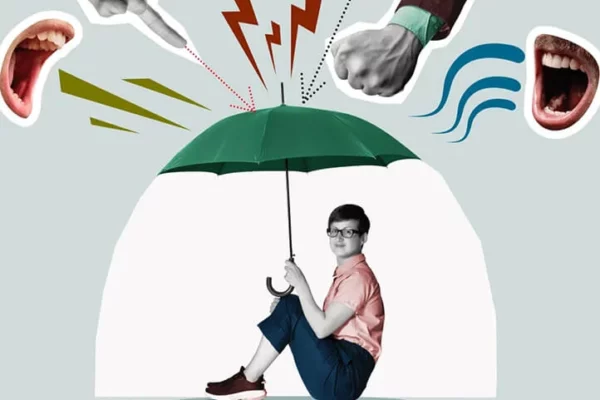In today’s world, where information and opportunities seem limitless, many of us paradoxically find ourselves trapped in limited thinking. This phenomenon, known as tunnel vision, can significantly impact our lives, careers, and relationships.

What is Tunnel Vision?
Tunnel vision is a psychological phenomenon in which a person focuses on a narrow range of ideas or possibilities, ignoring alternative options or the bigger picture. Much like in a tunnel where we see only what is directly ahead, tunnel vision narrows our perception to a specific perspective or solution.
Psychological Mechanisms
Several psychological mechanisms underlie tunnel vision:
- Cognitive biases. Our brain tends to simplify information and use mental shortcuts, which can lead to erroneous conclusions. For example, confirmation bias drives us to seek information that confirms our existing beliefs, ignoring contradictory data.
- Fear of the unknown. Uncertainty and new situations can cause anxiety, making us stick to familiar thought patterns. This is an evolutionary mechanism that once aided survival but often limits our potential in the modern world.
- Stress and pressure. In stressful situations, our thinking often narrows, focusing on the most obvious or familiar solutions. This is linked to the activation of the sympathetic nervous system, which prepares the body for a “fight-or-flight” response.
- Anchoring effect. The first piece of information or impression can heavily influence our subsequent thinking and decision-making, “anchoring” us to a specific viewpoint.
- Dunning-Kruger effect. People with limited knowledge or experience in a given field often overestimate their abilities, leading them to ignore alternative opinions or new information.
Neurobiological Basis
Tunnel vision also has a neurobiological basis. Research shows that under stress or strong emotions, the activity in the prefrontal cortex, responsible for complex thinking and decision-making, decreases. At the same time, the amygdala, involved in emotional reactions and fear processing, becomes more active. This results in a more primitive, “tunnel-like” perception of situations.

Signs and Characteristics of Tunnel Vision
Tunnel vision often appears subtly, gradually narrowing our perception of reality. Just as water drop by drop can carve a stone, habitual thought patterns create deep grooves in our minds. These mental grooves become comfortable and familiar, leading us to follow the same path repeatedly.
However, the comfort of a familiar path can be deceptive. What feels safe and reliable may limit our potential and hinder growth. Tunnel vision becomes invisible shackles that we place on ourselves, without realizing how much they restrict our movement.
Key Characteristics
- Rigidity of thought. An inability to consider alternative perspectives or solutions. The person stubbornly adheres to one approach, even if it is ineffective.
- Fixation on one aspect. Excessive focus on one detail of a problem, ignoring other important factors. For example, focusing only on salary when choosing a job, ignoring work conditions, growth opportunities, and team atmosphere.
- Resistance to change. A reluctance to try new approaches or methods, even if the old ones are ineffective. This often manifests in phrases like “we’ve always done it this way” or “why change something that works.”
- Black-and-white thinking. A tendency to see situations only in extremes, without accounting for nuances. For example, perceiving people as entirely good or entirely bad, without acknowledging the complexity of human nature.
- Repetitive thoughts. Constantly returning to the same ideas or problems without progress in solving them. This can manifest as obsessive thoughts or continuous “rumination” on past situations.
- Ignoring context. An inability to consider the broader context of a situation, leading to decisions that may be suboptimal in the long run.
- Emotional reactivity. Strong emotional reactions to contradictory information or alternative viewpoints, rather than a rational consideration of them.
Examples of Tunnel Vision in Everyday Life
- At work. An employee persistently uses outdated work methods, refusing to learn new technologies, even when this clearly reduces productivity and work quality.
- In relationships. A partner constantly blames the other for problems without considering their contribution to the situation. For instance, attributing all conflicts to the partner’s character, ignoring one’s own behavioral patterns.
- In decision-making. A person considers only two options (“either-or”), ignoring many other possibilities. For example, when choosing a career, considering only “staying at the current job” or “quitting,” overlooking the possibilities of negotiating a change in conditions, part-time work, or transferring to another department.
- In self-esteem. Constantly fixating on one’s flaws while ignoring achievements and strengths. This can manifest as a negative inner dialogue and constant self-criticism.
- In political views. Strict adherence to the ideology of one political party, refusal to consider opponents’ arguments or seek compromise solutions.
- In consumer behavior. Loyalty to one brand or product, refusing to try alternatives, even when they might be better or more advantageous.
- In education. A student who focuses only on getting high grades, ignoring opportunities to apply knowledge practically or develop skills.

Who Is at Risk?
Tunnel vision does not discriminate; it can affect anyone, regardless of age, education, or social status. However, some factors make us more vulnerable to its influence.
Interestingly, qualities we often consider our strengths may sometimes lead us to tunnel vision. For example, an expert in their field may be so confident in their knowledge that they stop noticing new ideas and approaches. Paradoxically, deep knowledge in one area can create a sort of blinders that limit our peripheral vision.
Recognizing one’s potential vulnerability is not a sign of weakness but rather a sign of wisdom. By understanding which factors might make us more prone to tunnel vision, we can take preventive measures, actively working to expand our horizons and develop intellectual flexibility.
Factors That Increase the Likelihood of Tunnel Vision
- High stress levels. People who are constantly in stressful situations are more prone to narrowed focus. Chronic stress can cause a person to become “stuck” in survival mode, losing the ability to see the bigger picture.
- Low self-esteem. Insecurity can lead to a fear of experimentation and risk-taking. People with low self-esteem often avoid new situations, preferring to stay in their comfort zone, which intensifies tunnel vision.
- Perfectionism. The pursuit of an ideal can lead to an obsession with details, missing the overall picture. Perfectionists are often so focused on achieving a “perfect” result that they lose sight of other important aspects of the situation.
- Rigidity of character. People with inflexible thinking are more likely to fall into the trap of tunnel vision. This may be due to personality traits or upbringing in a strict, authoritarian environment.
- Lack of experience or education. A limited worldview can narrow the perception of possibilities. People without diverse life experiences or education may not be aware of alternative approaches to problem-solving.
- Cultural factors. Some cultures encourage conformity and adherence to tradition, which can reinforce tunnel vision.
- Age. As people age, they may become less flexible in their thinking, though this is not a universal rule.
- Professional deformation. Long-term work in one field can lead to the formation of fixed thought patterns characteristic of that profession.
Occupations and Situations That Contribute to the Development of Tunnel Vision
- Highly specialized professions. Specialists may suffer from professional deformation. For example, a programmer who sees all problems through the lens of code or a doctor who interprets all life situations from a medical standpoint.
- Leadership roles. Leaders who have been in power for a long time may become less receptive to new ideas. This can be associated with an “echo chamber effect,” where the leader surrounds themselves with people who share their views.
- Crisis situations. In times of crisis, people often focus on survival, ignoring long-term perspectives. This is an evolutionary mechanism that may be useful in the short term but harmful when applied over the long term.
- Monotonous work. Routine tasks can dull creativity and flexibility of thought. Workers on assembly lines or call center operators are particularly at risk.
- Military and law enforcement. Strict hierarchy and the need for quick decision-making can contribute to the formation of rigid thought patterns.
- Creative professions in commercial settings. Paradoxically, creative workers who are constantly required to meet commercial demands may develop tunnel vision regarding their creative process.
- Academic environment. Researchers who work for a long time on a narrow topic may become “victims” of their specialization, losing the ability to see interdisciplinary connections.

How dangerous is tunnel vision?
Tunnel vision resembles an invisible virus that gradually affects various aspects of our lives. Its influence can be so subtle and gradual that we don’t notice changes until we find ourselves trapped by our own limitations. Just as an unnoticed current can carry a boat far from its intended course over time, tunnel vision can quietly lead us away from our true goals and potential.
Tunnel vision is especially dangerous because it often disguises itself as rationality and caution. We may convince ourselves that we’re avoiding risks and making “safe” decisions without realizing we’re actually cornering ourselves. This illusion of safety can become the biggest threat to our growth and success.
In an era of rapid changes and global challenges, tunnel vision becomes not just a personal issue but a potential threat to society as a whole. When leaders and entire organizations fall prey to limited thinking, it can lead to serious consequences, from economic crises to social conflicts.
Personal Consequences
- Missed Opportunities. People may overlook promising chances due to a narrow focus. This applies to career opportunities, personal relationships, or financial decisions.
- Stagnation in Development. The lack of new ideas and approaches leads to stagnation in both professional and personal growth. One may feel “stuck” at one level while the world around them changes.
- Deterioration of Relationships. The inability to understand others’ perspectives can lead to conflicts and broken connections, particularly in family and romantic relationships where empathy and mutual understanding are crucial.
- Stress and Anxiety. Constantly focusing on the same issues can cause psychological discomfort, leading to anxiety disorders and depression.
- Reduced Adaptability. In a rapidly changing world, the inability to adapt to new conditions can severely limit life prospects.
- Faulty Decision-Making. A limited view of a situation often leads to decisions that don’t consider all aspects of the problem. This can have serious consequences in finance, career, or personal life.
- Decreased Creativity. Tunnel vision limits the ability to generate new ideas and find unconventional solutions to problems.
- Physical Health Deterioration. Constant stress and negative emotions related to tunnel vision can harm physical health, weakening the immune system and increasing the risk of cardiovascular diseases.
Impact on Professional Activity
- Decreased Innovation. Companies with employees prone to tunnel vision are less inclined to innovate, which can lead to losing competitive advantage in the market.
- Decision-Making Errors. Ignoring alternative viewpoints can lead to suboptimal decisions. For instance, a company may miss important market trends by focusing solely on its current product.
- Loss of Competitiveness. In a fast-paced world, the inability to adapt can cost a business its success. A classic example is Kodak, which failed to pivot to digital photography in time.
- Team Conflicts. Disagreements between employees with different thinking styles can reduce work efficiency, especially in multicultural teams where approach differences are more pronounced.
- Reduced Productivity. Focusing on ineffective methods can significantly reduce labor productivity.
- Missed Collaboration Opportunities. Tunnel vision hinders the ability to see the potential for mutually beneficial collaboration with other companies or departments.
- Resistance to New Technologies. Employees with tunnel vision may resist adopting new technologies, slowing down the company’s progress.
Social Aspects
- Polarization of Society. Tunnel vision can amplify divisions among different groups of people, particularly noticeable in politics, where people increasingly prefer to communicate only with like-minded individuals.
- Slowed Progress. A society dominated by limited thinking is less capable of solving complex issues, including global challenges like climate change or social inequality.
- Spread of Misinformation. People with tunnel vision are more susceptible to fake news and propaganda, tending to uncritically accept information that aligns with their existing views.
- Loss of Cultural Diversity. The inability to appreciate different perspectives can lead to cultural homogenization, including the loss of linguistic diversity, traditions, and unique cultural practices.
- Reduced Empathy. Tunnel vision can lead to a diminished capacity to understand and empathize with people from different backgrounds or viewpoints.
- Strengthening of Social Stereotypes. Limited thinking often reinforces prejudices and stereotypes about various social groups.
- Difficulty in Solving Complex Social Problems. Issues requiring an interdisciplinary approach (e.g., poverty or healthcare issues) become harder to solve in a society dominated by tunnel vision.

How to Overcome Tunnel Vision and Start Seeing Opportunities?
Overcoming tunnel vision is not just about breaking a bad habit but is a genuine journey to a new way of perceiving the world, which begins with something small—the willingness to admit that our current perspective may be limited. Such acknowledgment requires courage and honesty with oneself.
Self-Diagnosis Methods
- Analyze Repetitive Patterns. Pay attention to situations where you consistently make the same decisions. Ask yourself, “Why do I always react this way?”
- Reflection. Regularly ask yourself, “Have I considered all possible options?”
- Feedback. Seek others’ opinions on your ideas and decisions, particularly those who think differently from you.
- Thinking Journal. Record your thoughts and decisions to track thinking patterns. Over time, you’ll notice recurring themes and approaches.
- Cognitive Flexibility Test. Psychological tests can assess your ability for flexible thinking. Try taking one and discuss the results with a psychologist.
- Blind Spot Analysis. Ask a friend or other trusted person to point out areas where they think you demonstrate rigidity or limited thinking.
Practical Exercises to Broaden Horizons
- “Six Thinking Hats.” Use Edward de Bono’s method to view problems from different perspectives. Each “hat” represents a specific way of thinking: facts, emotions, criticism, optimism, creativity, and process.
- Brainstorming. Generate as many ideas as possible without evaluating them immediately. Set a goal, such as 50 ideas in 10 minutes, and write down everything, even absurd thoughts.
- Reading Diverse Literature. Discover new ideas and perspectives through books and articles from various fields. Try reading books on topics that usually don’t interest you.
- Travel and New Experiences. Step out of your comfort zone to stimulate new thinking. This could be traveling to a new country or simply exploring a new area in your city.
- Meditation and Mindfulness. Practice techniques that help clear the mind and gain a fresh perspective. Regular meditation helps reduce stress and increase cognitive flexibility.
- Role-Playing. Try viewing a situation from another person’s perspective, like your opponent in a debate or someone from a completely different social group.
- Learning a New Skill. Acquiring a new skill, especially from a field far from your profession, can help develop new neural connections and foster more flexible thinking.
- “What If?” Practice. Regularly ask yourself questions like “What if everything were the opposite?” or “What if I had unlimited resources?” to broaden the field of possible solutions.
Creative Thinking Techniques
- Random Word Method. Connect your problem to a random word to generate new ideas. For example, if you’re thinking about a new product and the random word is “elephant,” consider how elephant characteristics might apply to your product.
- Reverse Brainstorming. Instead of looking for solutions, look for ways to worsen the problem, then invert the results. This can lead to unexpected insights.
- SCAMPER. Use the technique to modify existing ideas:
- Substitute;
- Combine;
- Adapt;
- Modify;
- Put to Another Use;
- Eliminate;
- Reverse.
- Mind Mapping. Visualize connections between ideas for a better understanding of the problem. Start with a central idea and develop branches representing related concepts.
- Analogies and Metaphors. Find similarities between your problem and completely different areas to gain a fresh perspective. For example, how might nature solve your problem?
- Method 635. Six participants write three ideas on a sheet of paper in five minutes. The sheets are then circulated, and the process repeats until each participant has worked on each sheet.
- Synectics. Use analogies to find new approaches to a problem, considering direct analogies (how is this problem solved in other fields?), personal analogies (if I were this problem, what would I feel?), symbolic analogies (what images come to mind?), and fantastic analogies (how would a superhero solve this?).
- Focal Objects Method. Choose a random object and apply its properties to your problem or product, leading to unexpected combinations and innovations.

How to Combat Tunnel Vision in a Team?
Tunnel vision in a team is like an invisible wall that gradually builds up between team members, restricting the flow of ideas and innovation. This wall can be particularly dangerous, often disguising itself as unity and consensus. A team may take pride in its cohesiveness, unaware that this cohesion is based on shared limitations rather than true diversity of opinions and approaches.
Overcoming tunnel vision within a team requires not only individual efforts but also the creation of a culture of openness and innovation. Just as an ecosystem thrives due to species diversity, a team reaches its highest efficiency when diversity of opinions and approaches is valued and encouraged.
Leaders play a key role in this process, acting as “gardeners of thought.” Their task is not only to identify and eliminate the “weeds” of tunnel vision but also to create fertile ground for the growth of new ideas. This requires a delicate balance between encouraging innovation and maintaining focus on the team’s goals.
Signs of Tunnel Vision in a Team
- Lack of discussion: The team quickly agrees on all suggestions without discussion. This could indicate a reluctance or fear of expressing alternative views.
- Resistance to new ideas: Innovative proposals are consistently rejected in favor of tried-and-true methods. The team prefers “not to rock the boat.”
- Uniformity of opinions: All team members hold similar views on problems and solutions. There is no healthy diversity of perspectives.
- Ignoring external information: The team disregards data or opinions that contradict its beliefs. This may manifest in ignoring client feedback or market trends.
- Repeating past mistakes: The team does not learn from its mistakes and repeats ineffective strategies. There is no culture of analyzing and learning from failures.
- Fear of risks: The team avoids any risky decisions, even if they could yield significant benefits.
- “Halo effect”: Excessive trust in the opinion of one or a few team members, typically leaders or experts, without critical analysis of their ideas.
- Avoidance of conflicts: Team members try to avoid disagreements, resulting in superficial agreement rather than productive debates.
Strategies for Leaders
- Encourage diversity: Form teams with varied experiences, backgrounds, and perspectives. Diversity promotes innovation and helps avoid groupthink.
- Create a safe environment: Ensure an atmosphere where employees are not afraid to voice alternative opinions. Encourage constructive criticism and open dialogue.
- Role rotation: Periodically change team members’ responsibilities to provide new experiences. This helps develop empathy and understanding of different aspects of the work.
- External expertise: Bring in consultants or experts from other fields for a fresh perspective, which can help identify the team’s “blind spots.”
- Teach critical thinking: Conduct training to develop skills in analyzing and evaluating information. Teach employees to recognize cognitive biases and logical errors.
- Encourage innovation: Establish a system that rewards innovative ideas, even if they aren’t always successful. This stimulates creative thinking and reduces fear of risks.
- Practice “Red Teaming”: Assign a group of employees to critically evaluate and challenge key assumptions and plans. This helps identify potential issues and improve strategies.
- Regular feedback: Implement a culture of continuous feedback where employees can openly discuss issues and suggest improvements.
- Cross-functional collaboration: Encourage collaboration between different departments and teams. This facilitates the exchange of ideas and broadens perspectives.
- Alternative scenario analysis: Regularly hold sessions to develop and discuss alternative scenarios for the situation’s development. This prepares the team for various future possibilities.
Exercises and Activities for the Team
- “Devil’s advocate”: Assign someone to intentionally challenge proposed ideas. This helps identify weaknesses in arguments and promotes critical thinking.
- Creative breaks: Set aside time during meetings for a free exchange of ideas unrelated to the current task. This can lead to unexpected insights and innovations.
- Nominal group technique: This method combines individual idea generation with group discussion, helping to prevent domination by specific personalities in decision-making.
- Problem visualization: Ask the team to draw or diagram the problem. Visual representation helps reveal new aspects and connections.
- Random stimulus: Introduce a random object or concept into the discussion and ask the team to connect it to the current problem. This stimulates unconventional thinking.

Conclusion
Tunnel vision represents a serious challenge to personal and professional development in the modern world. It limits our perception, narrows the range of possibilities, and can lead to stagnation both on an individual level and within organizations and society as a whole. However, recognizing this problem opens the way to overcoming it.
Fighting tunnel vision is an ongoing process requiring constant vigilance and practice. It begins with acknowledging our own limitations and willingness to go beyond them. It is a journey toward a broader, multifaceted perception of the world that enriches our lives with new perspectives and opportunities.
Developing critical thinking, encouraging diverse opinions, and creating an environment that fosters open exchange of ideas are key steps in this journey. It is important to remember that overcoming tunnel vision is not only a personal task but a collective responsibility. In teams and organizations, this requires creating a culture that values innovation, encourages constructive criticism, and embraces diverse viewpoints.
By investing time and effort in expanding our worldview and developing cognitive flexibility, we not only improve the quality of our decisions but also enrich our lives. We become more adaptable, creative, and open to new opportunities. This enables us to better face the challenges of a rapidly changing world and actively shape the future by creating innovative solutions and opening new horizons.




